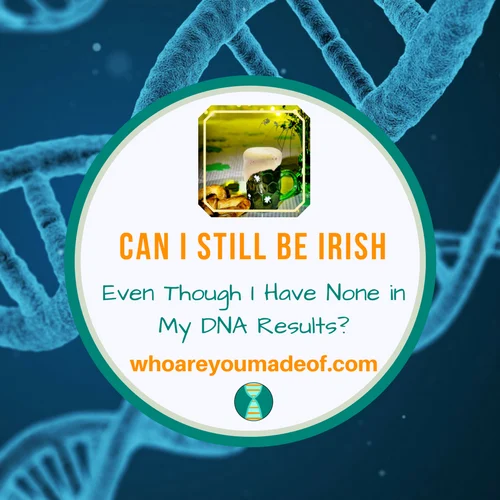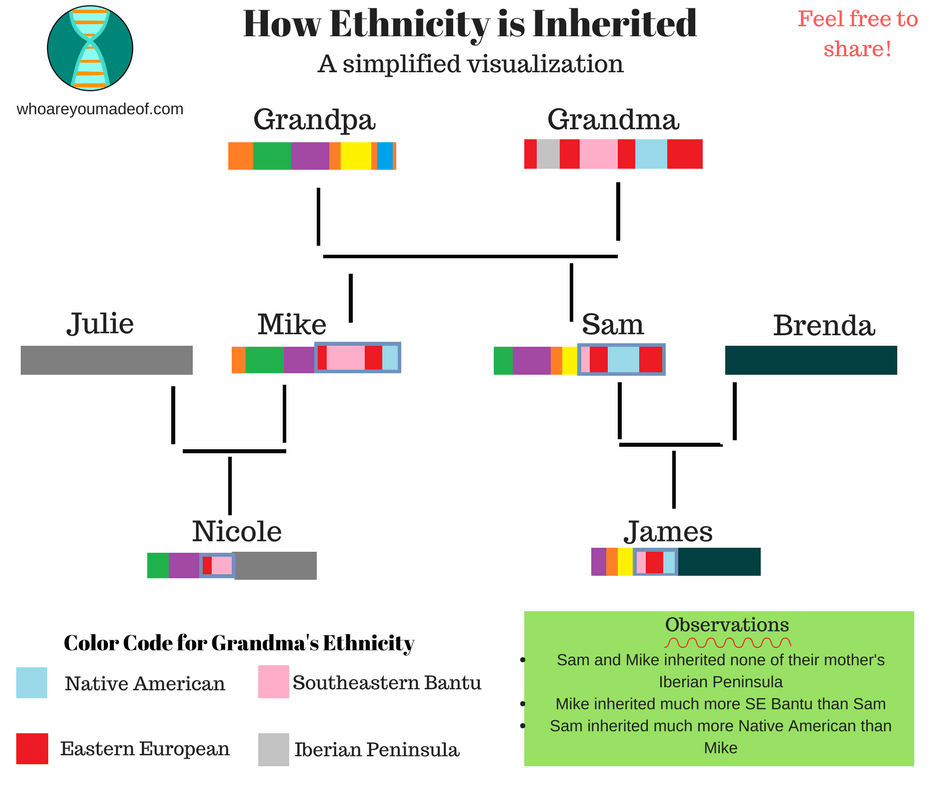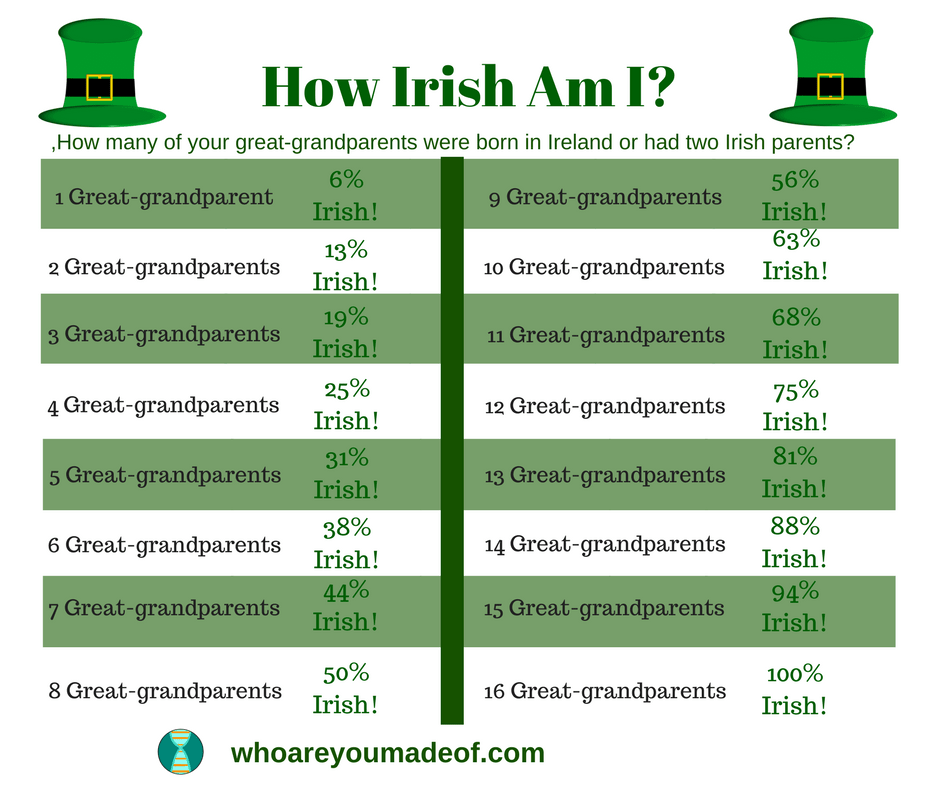If you did a DNA test expecting to find more Irish, or at least some Irish, represented in your ethnicity results, you are not alone. Many people are surprised to find Irish, and others are surprised not to find Irish in their DNA.
With St. Patrick's Day always around the corner, you might be asking if you can still be Irish even though you have none in your DNA results. And if you can be Irish - without showing an ounce of Irish in your DNA - how can you know how Irish you really are?

In my own family, we found ourselves asking ourselves this exact question. Before I did my DNA test, I was expecting to see between 12-15% Irish DNA, at minimum, based on the little information I had about my family's history.
When I got my results back, I only showed 9% Irish DNA. It really got me thinking about these ethnicity estimates, and whether or not we should let our DNA results dictate how Irish (or any other nationality or ethnicity) someone feels like they are.
You are reading this article to help determine how Irish you might be, even if your DNA results don't show much Irish, or any at all. I have some clues, however, that just might make you feel better about putting on your "Kiss Me, I'm Irish" t-shirt this year.
In this post, I'll give you some pointers to help get you started in finding the truth about your family's ancestry.
Your Irish ethnicity, or lack thereof, is only an estimate
There are a few tricky things going on when it comes to ethnicity estimates, and the way that ethnicity is inherited. The further back your Irish ancestors were, the bigger the effect these ethnicity inheritance facts will have on you.
Keep reading to learn more about why your estimate is only truly an estimate and can never be a complete, detailed report about your ancestry.
We don't share DNA with all of our Irish ancestors
We have 2 parents, 4 grandparents, 8 great-grandparents, 16 great-great grandparents, 32 great-great-great grandparents, 64 great-great-great-great grandparents, and 128 great-great-great-great-great grandparents. Do you see a pattern here?
If you go back only seven generations in your family tree (to the 5th great-grandparent), you have 128 ancestors. What is the reason for this? Your genome is not long enough to "fit" DNA from all of these ancestors.
This is one reason why we don't share DNA with all of our relatives.
This means that if even if you have 3 or 4 Irish 5th great-grandparents, it's possible that you would share absolutely no DNA with them. If they were alive today (oh how I wish I could meet some of my 5th great-grandparents!), you will not share genetic material with all of your 5th great-grandparents.
In fact, it is statically possible to share no DNA with a great-great grandparent, though not probable. As you go back further, generation by generation, the probability that you inherited no DNA from a particular ancestor increases.
Additionally, even if you do happen to share DNA with a great number of your distant ancestors, you will only share small amounts. This is important to remember for those of us who were expecting to see larger percentages of Irish DNA in our results.
Ethnicity is not passed down in equal segments
A common misconception when it comes to ethnicity inheritance is that a child inherits 50% of someone's ethnicity, a grandchild 25%, a great-grandchild 12.5%, and a great-great grandchild 6.25%. While this can certainly happen, it isn't how it usually happens.
Generally speaking, ethnicity is inherited in a process like this example:
- Imagine that your parents each have a basket of colored marbles (each parent has 100 marbles). You will take 50% (exactly 50) of the marbles out of each basket. Your genome can only fit 100 marbles, total. That's why you can't have all of the marbles from each of your parents - there just isn't enough room.
- If you decide to have a child, your child will take 50% of your marbles, and 50% of the marbles belonging to your spouse. Fortunately, no one loses all of their marbles during this process, though parenting can certainly make us feel like this has happened!
- If you ever become a grandparent, your grandchildren will inherit 50% of their marbles from your child, and 50% of their marbles from their other parent
- Your great-grandchild will inherit 50% of their marbles from their parent (your grandchild) and 50% of their marbles from their other parent
Do you notice how each generation, 50% of the marbles are not inherited? If your parents are the "original" ancestors in this example, they will still share DNA with your great-grandchild, but much less than you might expect.
This is because of probability. DNA inheritance is random, and while there is a 100% chance that a child will share 50% of their DNA with each parent, as the generations pass and the "original ancestors" become more distant, there are simply too many marbles to choose from.
Eventually, "the odds" win, and a child will randomly not inherit DNA from an ancestor - in our case, they will not inherit Irish DNA. From that point on, no more DNA from those "original" ancestors will be passed down to future generations, including the Irish ethnicity and DNA segments that they might have shared with other descendants of those same ancestors.
As I mentioned before, this is why we are less likely to share DNA with our distant cousins. Those "odds" will have us sharing small identical DNA segments with some, but not all of them.
Below is a simplified visualization of how ethnicity is passed down, no matter which ethnicity we are wondering about. In a real-world example, DNA would not be passed down in DNA segments as large as intact as the ones you see below.
The DNA in the blue square is the DNA inherited from Grandma, and the colored DNA that is not in a square is from Grandpa. You can see how the grandchildren (Nicole and James) share a much smaller amount of DNA with Grandma and Grandpa than Mike and Sam do.
This effect is more pronounced as more generations pass. Eventually, the descendants of Nicole and James would no longer share DNA with Grandpa and Grandma.

Your ancestors might not have been as Irish as you think they were
The final reason that you might not have inherited the Irish DNA that you were expecting is because your Irish ancestors might not have been as Irish as you think they were. Even though Ireland is an island nation, it's actually pretty close to many other countries, from a geographic, economic, and cultural standpoint.
Ireland has Spain to the south, Scotland, Wales, and England to the east, and Iceland to the north. There is a good chance that your Irish ancestor was not "100%" Irish, and if this was the case, especially considering what you now know about how ethnicity is passed down, it should not be a surprise to show less Irish ethnicity than expected.
If your ancestors were less "genetically" Irish than we might believe based on their genealogy records, then there was less Irish DNA for you to inherit. In fact, you may have inherited DNA from them - just not the DNA segments that match the Ireland region.
So, if my DNA can't tell me how Irish I really am, how can I figure it out?
It's possible to get an estimate on how Irish you really are, but it might take a little bit of research on your part. You are going to have to figure out where all of your great-great grandparents were born (or great-great-great grandparents, if you really want to get really wild and crazy) and then use the chart below to see how Irish you are.

But I don't know how many Irish ancestors I have!
If you don't know where all of your great-great grandparents were born, then the easiest thing to do is build a small family tree on Ancestry. You can build your tree for free and get access to really cool records that make it very easy to research your family tree right from the comfort of your living room.
I secretly hope that you will love building your family tree and turn it into a new-found hobby, but it's okay if you are only interested in figuring out how Irish you are.
Conclusion
I hope that this post helped you understand a little bit about how you can totally still be Irish, even though you don't have any showing up in your DNA results. If you have any questions, comments, or would like to share your experience about how you found out that you are Irish, I would love to hear from you below.
Thanks for stopping by!


Hazel Guay
Friday 19th of May 2023
My dad always told me he was French and Irish. I had my dna done and it turns out I have no Irish but I have German , English, Scottish, welsh and a few others. So can I still be Irish ?Hazel
Dennis
Sunday 13th of November 2022
Both my grandparents on my father's side came from Ireland. On my mother's side they came from France and were Jewish. I have traced both sides of the ancestry back to early 1800's. I even have cousins living in Ireland. When my DNA was done, as was my brothers and sisters no Irish is shown. How can half my family come from Ireland and yet no Irish DNA?
Peggy
Monday 29th of November 2021
My father was 100% Irish as far as I know. His mother immigrated from County Sligo, Ireland and his father from County Leitrim but he was born here in the US. My mother was born in the US but both her parents came from Southern Italy. I show 80% Sicily, 6% Levant, and 14% Cypress. There is no evidence of Irish in the DNA, At first the results were more accurate but they keep changing it. My first result from Ancestry showed 2% Irish but now nothing? While I have absolutely no doubt that my deceased father was in fact my father this has gotten me obsessed and depressed. My former doctor always told me I had that same lazy eye like my father although I truly looked all Italian. To be completely honest I do not want to do another DNA test because I feel that if the results are the same I will get more upset. My ancestry DNA shows a cousin as my brother. This cousin mom and my mother were sisters. This cousin's father was a cousin to his mother from Italy thus my mother would have also been a cousin to her brother-in-law. However, him showing up as a brother is embarrassing and I am wondering why I even did this DNA in the first place. I assume this comment will not be shown on this website and is private. Thank you for any response or reassurance.
Pam Naylor
Thursday 4th of November 2021
My paternal grandfather was Irish (58 when my father was born) but I do not have any Irish in my DNA. Can this be true?